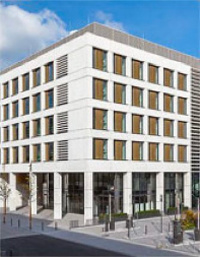The majority of cases of steroid-resistant nephrotic syndrome (SRNS) and focal segmental glomerulosclerosis (FSGS) in childhood and adolescence are caused by mutations in single genes. While the probability of single-gene causes of FSGS declines with age there is a clear role for genetic susceptibility also in sporadic forms of FSGS in adulthood. Although the past two decades have witnessed spectacular breakthroughs in the understanding of the genetics of SRNS/FSGS, the molecular basis of SRNS/FSGS development is far from being understood.
We recently used CRISPR/Cas9 genome engineering to develop new mouse models that genetically and phenotypically mimic human SRNS. These models were meticulously studied by super-resolution (STED) microscopy and quantitative morphological analyses. Mathematical modeling revealed surprising discoveries that will change the way how we think about albuminuria: We showed that shortening of the slit diaphragm precedes albuminuria development and that slit diaphragm length inversely correlated with the magnitude of albumin loss, a very unexpected finding. Moreover, morphological alterations of the glomerular filtration barrier in disease appeared to impair compressive forces that counteract filtration pressure which resulted in reduced compression of the glomerular basement membrane and ultimately in albuminuria. These data resulted in the first experimentally validated model of glomerular ultrafiltration.
The overall aim of this research project is to elucidate the pathogenic mechanisms that link the genetic mutation with these initial morphologic alterations and to apply deep learning algorithms to gain a deeper understanding of those changes. As such, this project continues to work on the most recent breakthrough technical achievements. Specifically, we will elucidate the mechanisms that determine the quantitative changes in the morphological properties of the SD and of podocytes’ foot processes, decipher the biophysical mechanisms of renal filtration using deep learning algorithms and computational modeling, and characterize the impact of altered SD and foot process morphology on genetic susceptibility for FSGS. We hope that this will result in potential novel treatment strategies for delayed-onset genetic forms of FSGS.
PROJECT RELATED PUBLICATIONS
Unnersjo-Jess, D., Butt, L., Hohne, M., Witasp, A., Kuhne, L., Hoyer, P.F., Patrakka, J., Brinkkotter, P.T., Wernerson, A., Schermer, B., Benzing, T., Scott, L., Brismar, H., and Blom, H. (2021) A fast and simple clearing and swelling protocol for 3D in-situ imaging of the kidney across scales. Kidney Int, 99(4): 1010-1020.
Butt, L., Unnersjo-Jess, D., Hohne, M., Schermer, B., Edwards, A., and Benzing, T. (2021) A mathematical estimation of the physical forces driving podocyte detachment. Kidney Int, 100(5): 1054-1062.
Butt, L., Unnersjo-Jess, D., Hohne, M., Edwards, A., Binz-Lotter, J., Reilly, D., Hahnfeldt, R., Ziegler, V., Fremter, K., Rinschen, M.M., Helmstadter, M., Ebert, L.K., Castrop, H., Hackl, M.J., Walz, G., Brinkkoetter, P.T., Liebau, M.C., Tory, K., Hoyer, P.F., Beck, B.B., Brismar, H., Blom, H., Schermer, B., and Benzing, T. (2020) A molecular mechanism explaining albuminuria in kidney disease. Nat Metab, 2(5): 461-474.
Binz-Lotter, J., Jungst, C., Rinschen, M.M., Koehler, S., Zentis, P., Schauss, A., Schermer, B., Benzing, T., and Hackl, M.J. (2020) Injured Podocytes Are Sensitized to Angiotensin II-Induced Calcium Signaling. J Am Soc Nephrol, 31(3): 532-542.
Rinschen, M.M., Godel, M., Grahammer, F., Zschiedrich, S., Helmstadter, M., Kretz, O., Zarei, M., Braun, D.A., Dittrich, S., Pahmeyer, C., Schroder, P., Teetzen, C., Gee, H., Daouk, G., Pohl, M., Kuhn, E., Schermer, B., Kuttner, V., Boerries, M., Busch, H., Schiffer, M., Bergmann, C., Kruger, M., Hildebrandt, F., Dengjel, J., Benzing, T., and Huber, T.B. (2018) A Multi-layered Quantitative In Vivo Expression Atlas of the Podocyte Unravels Kidney Disease Candidate Genes. Cell Rep, 23(8): 2495-2508.
Rinschen, M.M., Hoppe, A.K., Grahammer, F., Kann, M., Volker, L.A., Schurek, E.M., Binz, J., Hohne, M., Demir, F., Malisic, M., Huber, T.B., Kurschat, C., Kizhakkedathu, J.N., Schermer, B., Huesgen, P.F., and Benzing, T. (2017) N-Degradomic Analysis Reveals a Proteolytic Network Processing the Podocyte Cytoskeleton. J Am Soc Nephrol, 28(10): 2867-2878.
Huber, T.B., Schermer, B., Muller, R.U., Hohne, M., Bartram, M., Calixto, A., Hagmann, H., Reinhardt, C., Koos, F., Kunzelmann, K., Shirokova, E., Krautwurst, D., Harteneck, C., Simons, M., Pavenstadt, H., Kerjaschki, D., Thiele, C., Walz, G., Chalfie, M., and Benzing, T. (2006) Podocin and MEC-2 bind cholesterol to regulate the activity of associated ion channels. Proc Natl Acad Sci U S A, 103(46): 17079-86.



